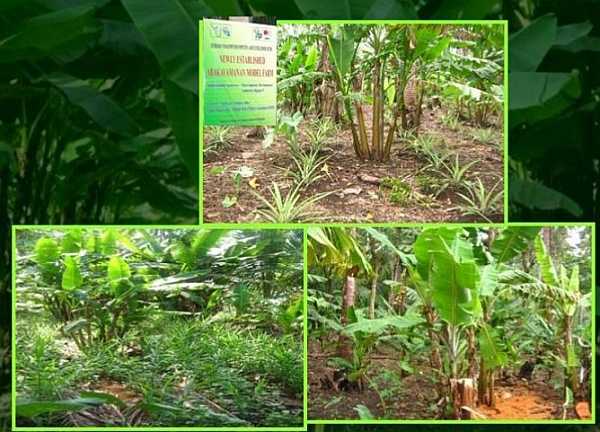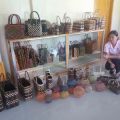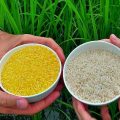An abaca integration project is hoped to be replicated in typhoon-damaged Leyte-Samar as Philippine abaca enhances its global competitive edge from its Rainforest Alliance certification.
A project that combines farming of abaca with other crops like coconut, “Abakayamanan” is envisioned to help farmers in typhoon-stricken provinces to bounce back through this technology.
The Abaca integration project implemented by the Fiber Industry Development Authority (FIDA) and financed by the Bureau of Agricultural Research (BAR) is called “Enhancing Productivity of Abaca Farms in Bicol through Integrated Farming System Abakayamanan”
“We may be able to duplicate Abakayamanan in Tacloban City. Even prior to the Yolanda, Leyte and Samar are the biggest provinces in abaca production,” said Dr. Editha O. Lomerio, Abakayamanan project head.
BAR has funded Abakayamanan by P1.8 million. The program has raised farmers’ income in two pilot areas by P14,400 per 1,000 square meters. The pilot areas are San Roque, Maliliput, Albay and Gubat, Sorsogon.
BAR Director Nicomedes P. Eleazar wants Abakayamanan implemented too in other abaca-producing provinces.
“We can have a holistic approach in our abaca production through Abakayamanan. Director Eleazar wanted it duplicated in many areas. It’s a food security source, and we may also have it as a zero waste crop,” said Dr. Editha O. Lomerio, Abakayamanan project leader.
Abakayamanan’s beneficiaries were Malilipot Abaca Planters Association in Albay and Gubat Abaca Growers Cooperative in Sorsogon.

Rainforest Alliance
The replication of the Abakayaman project in Leyte-Samar will enhance the marketing of quality abaca manufacturing in the Philippines especially in light of a certification for sustainable forest management obtained by manufacturers.
Abaca manufacturer Glatfelter (Germany) which has an abaca manufacturing plant in Barrio Maria Cristina, Balo, Lanao Del Norte has obtained a FSC (Forest Stewardship Council) from New York-based Rainforest Alliance.
Glatfelter manages Newtech Pulp, a producer and exporter of abaca pulp.
Glatfelter has been teaching its constituent farmers to plant trees sustainably. Its systems encourage greening of forest and soil erosion prevention.
Glatfelter manufactures composite fibers, specialty papers, and engineered products made from abaca.
Typhoon-damaged
As Eastern Visayas has been the biggest producer of abaca fiber in the country, planting of abaca will definitely help rehabilitate the typhoon-stricken provinces.
Leyte as a whole, Southern Leyte, and Northern Samar are among the country’s 10 biggest abaca producers. The other top provinces are Catanduanes, Lanao del Sur, Davao del Sur, Leyte, Sulu, Davao Oriental, Camarines Sur, and Surigao del Sur.
Total area as of 2011 devoted to abaca in the Philippines was 172,528 hectares at a total product of 73,274 metric tons of abaca fiber.
“The Bicol Region used to be the biggest in the country. It’s now just second to Eastern Visayas, “ according to an Abakayamanan report authored by Lomerio, Daniel Lachica, and Lea Casim.
Abaca has been plagued by destructive viral diseases including abaca mosaic, bunchy top virus, and abaca bract mosaic.
Abaca planting has also been adversely affected by destruction of forest ecosystems, non-adoption of production technologies, lack of information on value adding, and low farm gate price of abaca fibers.
Because of these factors, farm holdings in the Bicol Region have been reduced to less than three hectares per smallholder. Farmers have shifted to planting short—season crops like vegetables.
Environment-friendly
The very durable nature of abaca is not the only quality of this natural fiber that makes it in demand in the market.
Its environment-friendly, biodegradable nature makes manufacturers, especially those in Europe, to use abaca over synthetic fibers.
Coffee cups and tea bags are among the products that make use of abaca. These food containers highlights abaca fiber’s sanitary nature.
Many European institutions had already adopted a policy of turning away from non-biodegradables like plastics.
Biggest exporter
The Philippines is considered the world’s biggest supplier of abaca products with export value of around $100 million.
Opportunities abound as Ecuador, the Philippines’ next competitor in abaca supply, is reducing its abaca area, according to Lomerio.
The Philippines also has the competitive edge in abaca production due to its quality—durable, clean white, and long fibers.
The country exports its abaca pulp, fiber and other products mainly to the United Stated, Europe, and Japan.
There is an expanding markets for abaca fiber made into denim in Japan.
Composites, an engineered material that uses two or more combined raw materials, are a biodegradable industrial product used as a durable material used in interiors of luxury vehicles and aircrafts. This natural fiber can withstand pressures present in environments like those of aircrafts.
Employment
The abaca industry is a significant job generator.
As of 2011, FIDA noted it employed 111,112 farmers and 506 traders.
Employment in groups include 17 licensed traders-exporters; 13 licensed GBEs (grading and baling establishments); six cordage firms; six licensed pulp manufacturers; and 109 licensed fibercraft processors.
Abakayamanan
The BAR-FIDA project on Abakayamanan is an integration of abaca operations. First, there is intercropping particularly of abaca with coconut farms.
For short-gestating crops, among the crops integrated with abaca were okra, pechay, squash, eggplant, upo, mungbean, sweet potato, pole sitao, snap bean, ginger, papaya, and pineapple.
Abakayamanan brought a 13 percent increase in abaca area in Bicol Region to 50,212 hectares, employing 21,134 farmers. Bicol’s abaca fiber production contributes 37 percent of the country’s total production.
Abakayamanan implemented IFS or integrated farming system, disease management, Integrated Pest Management, and value adding through manufacturing of handicraft and other products. Integrated to abaca planting are animal (like goat) growing, mushroom growing, and composting to produce organic fertilizer.
Value adding
Among livelihood and value adding activities introduced in Abakayamanan in the two Bicol pilot areas were production of non-woven scrunch, bacbac bag making, and knotting. weaving, twinning, macramé, cordage-making, and handmade paper-making.
A mechanical dryer for abaca fiber drying was installed in Sorsogon. It was funded by Philippine Center for Post Harvest Development or Philmec.
Value added products from Abakayamanan are mushroom, sinamay, pinukpok, scrunch, macramé bag, wine holder, and crazy box. There are also wedding gown, barong, and casual dress.
As a world class product, the abaca bacbac bags commanded an attractive price of P400 to P550 per piece.
Product exhibition
Through the Japanese 2KR grant, the farmers’ cooperatives were able to join a product exhibition at SM Megamall in October 2010.
The abaca products were also exhibited at the International Agriculture and Tourism Expo Trade Fair at the World Trade Center in June-July
2011 and at BAR’s Techno Forum in SM Megamall in August 2011.
Production efficiency
Through technologies like IPM, germination of abaca seedlings was at a high of 87 percent in Sorsogon and 89 percent in Albay. Germination used to reach only about 50 percent.
“IFS are companion crops that provides structural support and protection during the germination period from rotting or attack of soil pathogens during heavy rains,” reported the Abakayamanan team quoting Trenbath.
Incidence of virus was also lower at eight to 10 percent compared to other nearby farms from the pilot areas that experienced around 40-50 percent infestation.
“Integrated farming encourages biodiversity that limits the virus disease cycle and regulated population buildup of aphid vector in the main crop. The more complex and diverse a community, the more stable it tends to be thus pest incidence is minimal.”
For the goat meat production, there were 35 farmer beneficiaries in MAPA.
Apart from Sorsogon and Albay, 10 other abaca farmers were trained on Abakayamanan. Other outreach activities were in the local government sof Castilla, Irosin, and Bulusan in Sorsogon.
“Abakayamanan upgraded abaca farming as a business. It was a sustainable source of income generation because of continuous marketing agreement. The markets came up as a result of quality and innovative products,” said the team.
Abaca varieties
The Abakayaman project has used organic fertilizer in order to promote environmental sustainability. Microorganisms were used to hasten decomposition of waste materials like leaves or stalks.
FIDA has stocks of different varieties of abaca that are location-specific. These may be used when replicating Abakayamanan in other provinces.
The abaca varieties are Laylay and Inusa in Visayas. In Bicol, among these are Tinawagan Pula and Tinawagan Puti.
In Davao, Bongolanon and Tangongon is a known abaca variety which used as a durable fiber. In Sulu, there is Bongolanon.
DA wants to have a continuous supply of finished products made from abaca.
Abaca uses
Abaca has many uses. Aside from fiber, it has many food values. Abaca leaves are used as growing material for mushroom. Coconut extract may be used as soap as it can heal psoriasis.
“We want to promote it as a zero waste crop,” said Lomerio.
Rep. Luis R. Villafuerte of the Bicol Region came up with a book on abaca “Abaca Philippines” showing many products from abaca. its crude extract may be used as a medicinal product to cure psoriasis.
Its bark’s core may be used as source of starch. The softest part of its stem may be used for lumpia just like how bamboo shoots are used for lumpiang ubod.
“In Apayao, natives have abaca-related cultivars whose stalk core is used use for lumpia,” said Lomerio.
The fiber is used for many things including handicraft, high quality bags.
“Our sinamay is used as blade for wind mills,” she said. Sinamay is a natural fabric made from abaca.
The flower of abaca may be used as hamburger material. Roots may be converted into fertilizer and feeds. The roots of abaca are of primary shallow root compared to hardwood trees which have deep roots. These may be uprooted more easily and may be chopped down to be made into fertilizer and feed.
Other products are electrolytic condenser paper, high grade decorative paper, Bible paper, coffee filter, meat and sausage casings, special art paper, cable insulation paper, adhesive tape paper, lens tissue, mimeograph stencil base tissue, carbonizing tissue, currency paper, checks, cigarette paper, vacuum cleaner bag, abrasive base paper, weatherproof bristol, map, chart, diploma paper, nonwovens, and oil blotting paper.
For any questions, kindly contact Dr. Editha O. Lomerio (FIDA) 09154435091; for interview requests, Ms Analiza C. Mendoza (Growthmagph) 09213383816, 09162666604. This press release is also available on https://growthmagph.com/?p=108.





